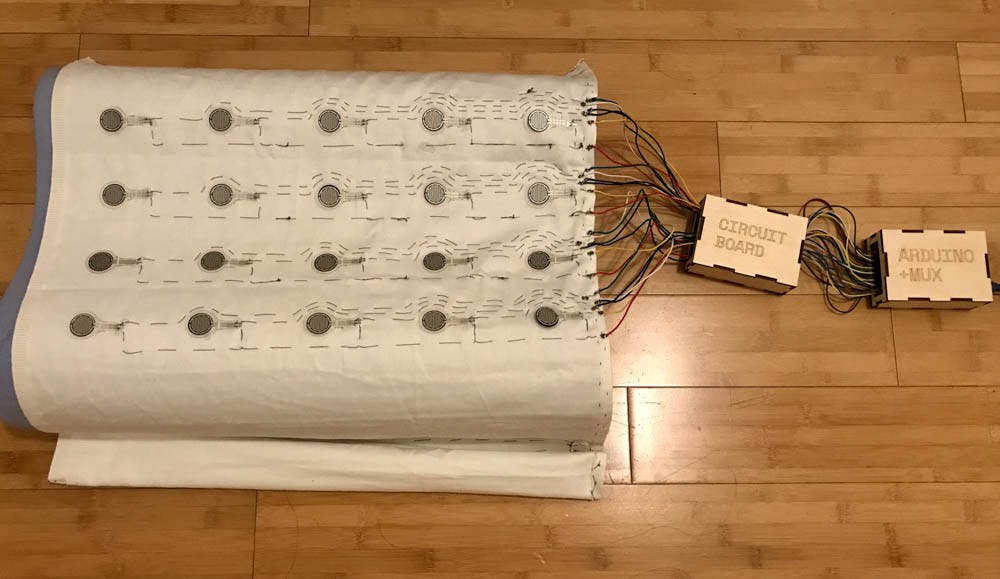Restless nights spent tossing and turning may soon be a thing of the past. Together with a team of undergraduates and CS faculty, Tiffany Chen ’18 created a smart pillow that can read users’ sleep patterns and give recommendations for improvement. With ongoing work from Jiaju Ma ’21, a RISD dual degree student, the pillow is improving its accuracy and expanding its capabilities.
The project began last fall, when Chen arrived on campus inspired by a summer spent interning at Microsoft and began planning a senior thesis with Assistant Professor of Computer Science Jeff Huang. With other members of Huang’s research group, Chen delved into the idea of personal fabrication, making everyday products that adapt to different users’ needs and environments.
Chen’s early ideas were based on the notion of inclusive design and were particularly inspired by a personal experience — getting a piercing on her right ear and being directed not to sleep on that side as it healed. She thought that if a smart sleep device could help her in that moment, it might be able to help others who experience different sleep impediments, including sleep apnea and other conditions.
While sleep-tracking devices exist — smartphones and Fitbits, for example — the group believed that these technologies may not monitor all aspects of sleep as seamlessly as something within the bed could. “We settled on a pillow … there’s enough cushion in there that we could put some sensors inside,” Huang said. Additionally, the pillow concept would allow them to combine different tracking devices such as accelerometers, gyroscopes and even pressure sensors. The team hoped that the pillow would be able to recognize whether a user typically slept on their side or back, for example, and then to “correlate that with when they wake up, how restful they feel,” he said.
After coming up with this concept, the team needed to design a way by which users could gather data from the pillow and receive the pillow’s recommendations. The answer was not a screen. “It’s not a good idea to be using computers before bed … the light makes it harder to fall asleep,” Huang said. Chen then did research to figure out the best way for users to interact with the device, ultimately deciding on voice user interface as the best approach. The interaction with a voice UI also allows the sleeper using the pillow to “calibrate” it by declaring when they are on their back or side. After this calibration, the pillow can learn on its own and track which position the user is in even when they are sleeping, Huang said.
The team used Botsociety, a tool that enables the creation of conversational scenarios that arise between a user and device, to diagram out what pillowtalk between the user and the pillow would be like, she said.
While making the prototype of the pillow, Chen said she relied on skills she had learned in her computer science and introductory engineering classes at the University. Though she didn’t end up pursuing an engineering degree, the intro classes she took taught her about building the circuits that now underlie the team’s pillow. She added that the key to the success of her project was “trial and error” and “a lot of good mentorship in the CS department.”
Chen graduated in the spring with degrees in Computer Science and Economics, but the pillow project will be continued by Ma, who studies industrial design and computer science. Ma received an Undergraduate Teaching and Research Award to work on the project this summer and will continue his involvement throughout the school year, he said.
This summer, Ma worked to improve the prototype by building a sensor pad to cover the surface of the pillow, connecting it to the sleep recommendation engine and making the whole system more portable. His work allows the pillow to more accurately read the users’ movements and position, suggest sleep changes and then follow up to see if those recommendations helped improve sleep.
The group hopes to have a singular sleep recommendation engine that can be used in a variety of ways through different devices, Huang said. Currently, the group has an app on the Google Play store called “SleepCoacher” which can be integrated with the pillow or used as a standalone app. They are still working on bringing their program to iOS.
Overall, the intention of the project is focused on “finding insights about human technology interaction versus creating something we can monetize,” Chen said.
“Our goal is just to have as many people use it as we can,” Huang said, adding that “we want to make something that anyone can make or get cheaply.”
In the future, the team plans to enter its work into the computer science research symposium“User Interface Software and Technology” and further develop the capabilities of the pillow itself, Ma said.





